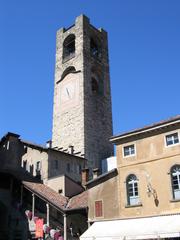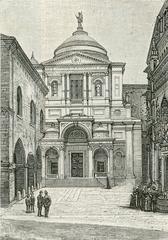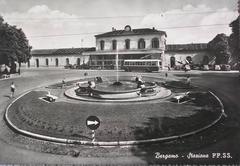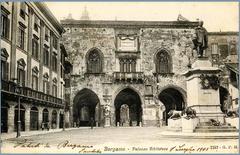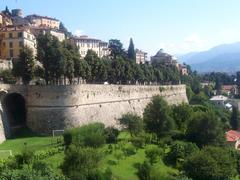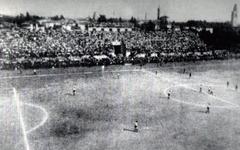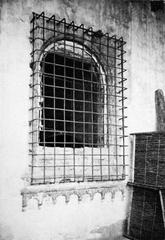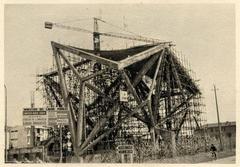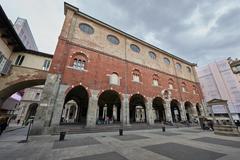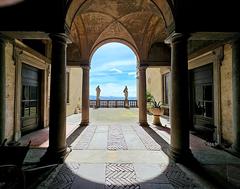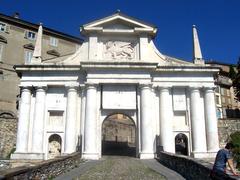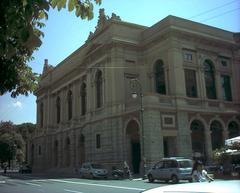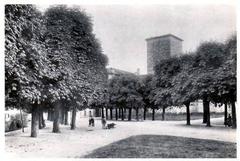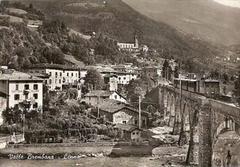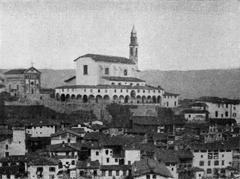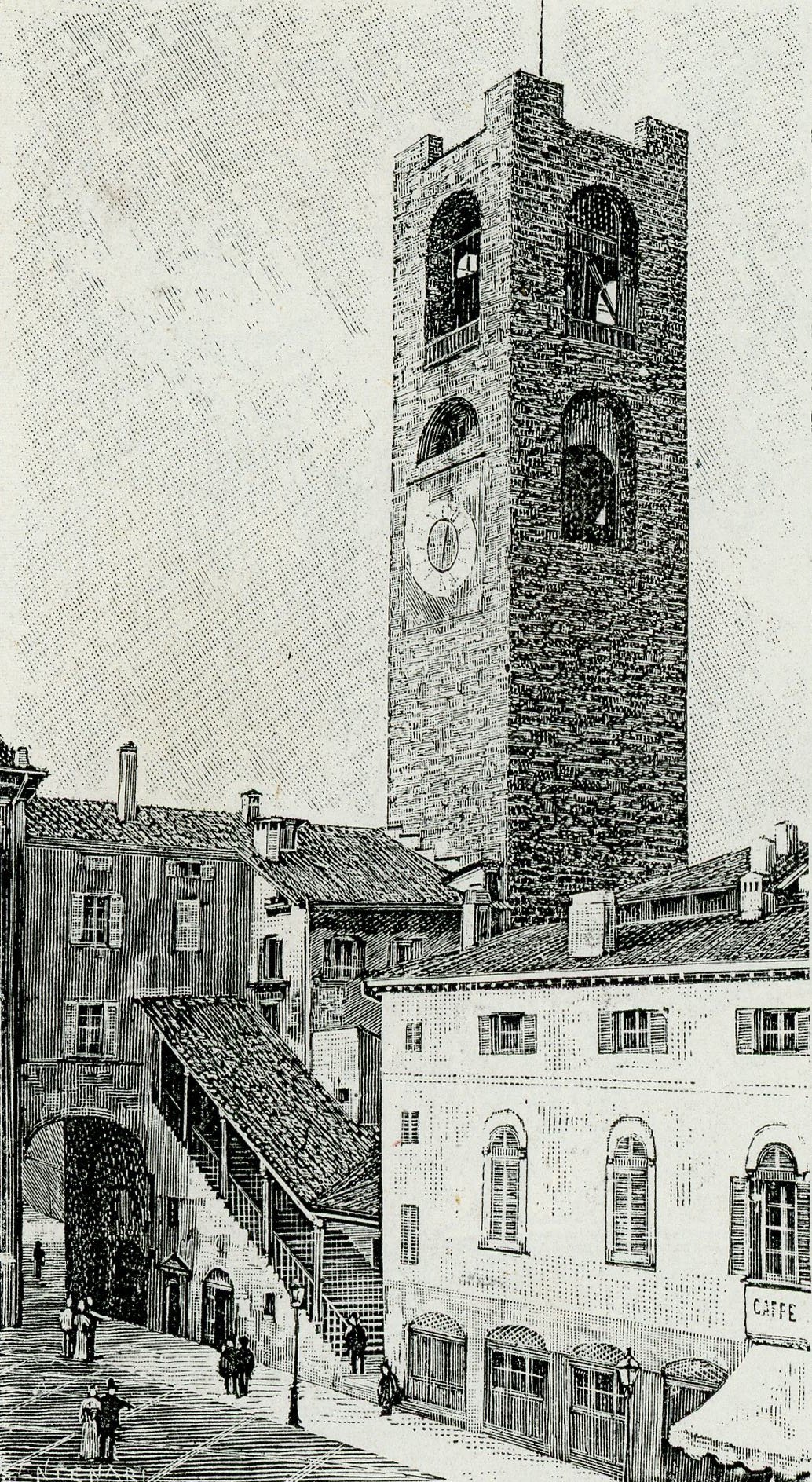
Visiting Campanone in Bergamo: Hours, Tickets, and Tips
Date: 24/07/2024
Introduction
Nestled in the heart of Piazza Vecchia in Bergamo, Italy, the Campanone, also known as the Civic Tower, stands as a testament to the city’s rich medieval heritage. The origins of this iconic tower trace back to the mid-12th century, constructed by the influential Suardi-Colleoni family. Its initial purpose as a house-tower, combining residential and defensive functions, reflects the architectural ingenuity of medieval Italy (Museo delle Storie di Bergamo). Over the centuries, the Campanone transitioned from a private residence to a public symbol, embodying Bergamo’s civic identity and playing a crucial role in the city’s governance and security. This transformation was marked by significant additions, including an imposing bell and a mechanical clock, which further solidified its status as a local landmark. Today, the Campanone remains a beloved monument, offering visitors a unique blend of historical insight and scenic beauty. Whether you are a history enthusiast, a cultural explorer, or simply seeking breathtaking panoramic views, the Campanone is a must-visit destination in Bergamo.
Table of Contents
- Historical Background
- Visitor Experience
- Travel Tips for Tourists
- Frequently Asked Questions (FAQ)
- Conclusion
Historical Background
Origins and Early Construction
The Campanone, also known as the Civic Tower, is a prominent historical landmark located in the heart of Piazza Vecchia in Bergamo, Italy. The construction of this iconic tower began in the mid-12th century by the influential Suardi-Colleoni family. Initially, it served as a house-tower, a common architectural feature in medieval Italy, combining residential and defensive purposes (Museo delle Storie di Bergamo).
Transition to Civic Symbol
When Bergamo was an independent township, the tower transitioned from private ownership to public property, symbolizing the city’s civic identity. This shift occurred alongside the Palazzo del Podestà, another significant building in the area. By the late 1200s and early 1300s, the tower was equipped with an imposing bell and a mechanical clock, enhancing its status as a local symbol (Museo delle Storie di Bergamo).
Structural Modifications Over Centuries
The Campanone has undergone numerous structural changes throughout its history. In the 1300s, prison cells were established at its base, reflecting its multifaceted role in the city’s governance and security. The 1600s saw the addition of a statue of Saint Alexander at the top of the tower, further cementing its religious and cultural significance. In the 1960s, modern renovations included the installation of a lift, making the tower more accessible to visitors (Museo delle Storie di Bergamo).
The Bell and Its Significance
The Campanone houses the largest historical bell in Lombardy, known as the Campanone. This massive bronze bell, cast by Bartolomeo Pesenti, measures 213 cm in diameter, 220 cm in height, and weighs 5,500 kg. The casting of the bell was fraught with challenges; the first attempt in 1652 ended in failure when the mold exploded. A subsequent attempt in 1653 succeeded initially but resulted in a broken bell a few months later. The final successful casting occurred on March 23, 1656, and the bell has remained a significant feature of the tower ever since (Museo delle Storie di Bergamo).
The Mechanical Clock
Between the late 1300s and early 1400s, a mechanical clock was added to the façade of the tower facing Piazza Vecchia. This clock marked the passage of civic and secular time, independent of religious and clerical schedules. It played a crucial role in the daily lives of Bergamo’s citizens, announcing the hours with bells that complemented those in the nearby Piazza Duomo, which marked liturgical events and rural workdays (Museo delle Storie di Bergamo).
Height and Renovations
In 1550, the Municipality of Bergamo decided to raise the height of the tower significantly to accommodate a new, larger belfry. The tower’s height increased from 37.7 meters to the current 52.76 meters. These renovations gave the Torre Civica its present form, which continues to dominate the skyline of Piazza Vecchia (Museo delle Storie di Bergamo).
The Venetian Influence
During the period of Venetian rule, the Campanone played a vital role in the city’s defense and administration. Every evening at 10 pm, the bell chimes 100 times, a tradition that dates back to the Venetian era. This nightly ritual originally served as a reminder for the closure of the city gates along the Venetian walls, marking the beginning of the curfew (Italy Magazine).
Modern-Day Significance
Today, the Campanone remains a beloved monument and a symbol of Bergamo’s rich history. Visitors can ascend the tower either by climbing 230 steps or taking the lift to enjoy breathtaking panoramic views of the old city, the pre-Alps, and the Lombard plains. The tower continues to be a focal point in Piazza Vecchia, surrounded by other historical landmarks such as the Palazzo della Ragione and the Contarini Fountain (Visit Bergamo).
Cultural and Civic Identity
The Campanone’s evolution from a private house-tower to a public civic symbol reflects the broader historical and cultural shifts in Bergamo. Its various roles—as a defensive structure, a prison, a bell tower, and a civic clock—illustrate its multifaceted significance in the city’s history. The tower’s enduring presence and the nightly chimes of its bell continue to connect the past with the present, making it an integral part of Bergamo’s cultural heritage (Lonely Planet).
Visitor Experience
Visiting Hours
The Campanone is open to the public from Tuesday to Friday between 10 am and 6 pm, and on weekends and holidays from 10 am to 7 pm. It is closed on Mondays and December 25th (Visit Bergamo).
Ticket Prices
Tickets are reasonably priced, with various discounts available for students, residents, and groups. Be sure to check the official website for the latest pricing information and special offers (Visit Bergamo).
Tour Options
Visitors can choose to explore the tower independently or join a guided tour for more in-depth historical context. Guided tours often provide detailed insights, enhancing the visitor experience.
Special Events
Throughout the year, the Campanone hosts various special events, including historical reenactments, cultural festivals, and nighttime tours. Check the event calendar on the official website to plan your visit accordingly.
Accessibility Information
The Campanone is equipped with a lift, making it accessible to visitors with mobility issues. However, be aware that some areas may still require climbing stairs. It’s advisable to contact the visitor center in advance for detailed accessibility information.
Nearby Attractions
While visiting the Campanone, you can also explore other nearby historical sites such as the Palazzo della Ragione, the Contarini Fountain, and the Basilica di Santa Maria Maggiore. These landmarks are all within walking distance and offer a comprehensive look at Bergamo’s rich history.
Travel Tips for Tourists
- Best Time to Visit: The best time to visit Bergamo and the Campanone is during the spring and autumn months when the weather is pleasant and the city is less crowded.
- Local Cuisine: Don’t miss out on trying Bergamo’s local cuisine, including polenta, casoncelli, and the famous Stracciatella ice cream.
- Transportation: Bergamo is well-connected by public transportation. Consider using the funicular railway to travel between the upper and lower parts of the city for a unique experience.
- Language: While Italian is the primary language spoken in Bergamo, many locals understand and speak basic English, especially in tourist areas.
Frequently Asked Questions (FAQ)
What are the Campanone visiting hours?
The Campanone is open from Tuesday to Friday between 10 am and 6 pm, and on weekends and holidays from 10 am to 7 pm. It is closed on Mondays and December 25th.
Are there guided tours available at Campanone?
Yes, guided tours are available and provide a more in-depth experience of the tower’s history and significance.
How much do tickets cost?
Ticket prices vary, with discounts available for students, residents, and groups. Check the official website for the latest pricing information.
Is the Campanone accessible to visitors with mobility issues?
Yes, the Campanone is equipped with a lift, but some areas may still require climbing stairs. Contact the visitor center for detailed accessibility information.
What other attractions are nearby?
Nearby attractions include the Palazzo della Ragione, the Contarini Fountain, and the Basilica di Santa Maria Maggiore, all within walking distance.
Conclusion
The Campanone, with its towering presence and rich historical significance, offers a captivating journey through Bergamo’s past. From its origins as a medieval house-tower to its evolution into a civic symbol, the tower encapsulates the city’s architectural and cultural heritage. Visitors can immerse themselves in the history of the Campanone by exploring its various facets, from the imposing bell to the mechanical clock that marked the passage of time for Bergamo’s citizens. The tower’s modern-day significance is enhanced by its accessibility and the breathtaking views it offers. As you explore the Campanone and its surrounding landmarks, including the Palazzo della Ragione and the Basilica di Santa Maria Maggiore, you gain a deeper appreciation for Bergamo’s rich history and vibrant culture. Whether you’re climbing the 230 steps or taking the lift to the top, the Campanone promises an unforgettable experience that connects the past with the present. Plan your visit today and discover the timeless charm of Bergamo’s iconic Civic Tower (Visit Bergamo).
References
- Museo delle Storie di Bergamo. (n.d.). Campanone. Museo delle Storie di Bergamo
- Italy Magazine. (n.d.). Bergamo: Medieval Splendor in Northern Italy. Italy Magazine
- Visit Bergamo. (n.d.). Torre Civica. Visit Bergamo
- Lonely Planet. (n.d.). Torre del Campanone. Lonely Planet
- Michael Harrison. (2014, May). Campanone: Venetian Museum & Roman Archaeological Discoveries. Michael Harrison
- Viaggio Magazine. (n.d.). Walk Along the Walls: A History Lover’s Guide to Bergamo’s Città Alta. Viaggio Magazine
- Travel Describe. (n.d.). Bergamo, Italy. Travel Describe
- Live the World. (n.d.). Torre Civica Campanone Bergamo. Live the World
- Into the Bloom. (n.d.). Bergamo Travel Guide. Into the Bloom

